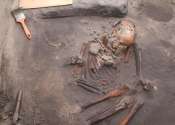Siberia's 'mammoth graveyard' reveals 800-year human interactions with woolly beasts
Woolly mammoths are evocative of a bygone era, when Earth was gripped within an Ice Age. Current knowledge places early mammoth ancestors in the Pliocene (2.58–5.33 million years ago, Ma) before their populations expanded ...









